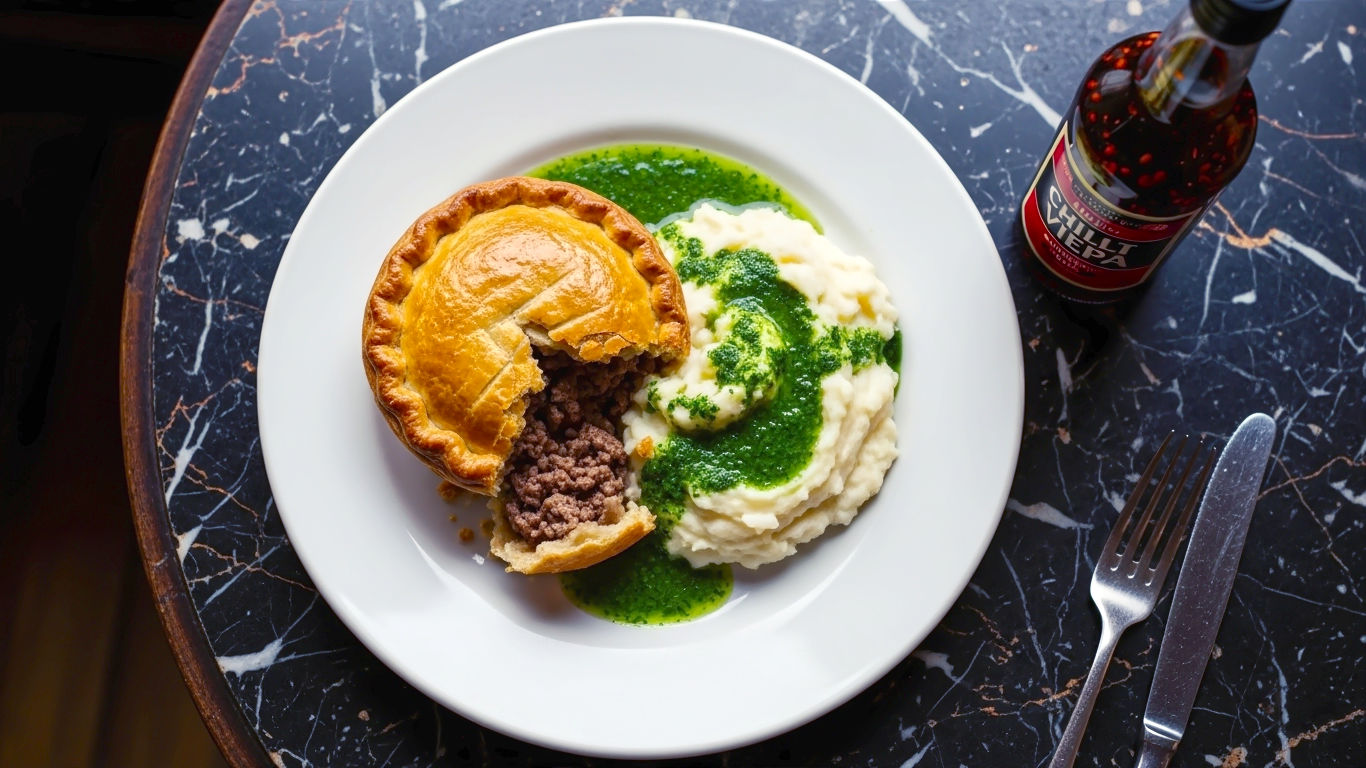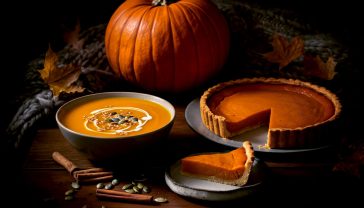The Pie and Mash Mile: A Definitive Guide to London’s Classic Comfort Food
Your definitive guide to the Pie and Mash Mile. Learn the history, meet the legendary owners, and discover how to eat this classic London dish like a local.

This post may contain affiliate links. If you make a purchase through these links, we may earn a commission at no additional cost to you.
There’s a stretch of road in East London that holds a special place in the city’s heart, and its stomach. It’s not marked on any official map, you won’t see it on a Tube sign, and your satnav will probably just call it the A13. But to those in the know, this artery pumping through Poplar, Canning Town, and Plaistow is affectionately known as the ‘Pie and Mash Mile’.
This isn’t just about food; it’s about history, community, and a taste of authentic London that has stubbornly refused to disappear. For over a century, pie and mash shops have been serving up a simple, hearty meal: a minced beef pie, a scoop of mashed potato, and a ladle of bright green parsley sauce known as liquor. It’s a dish born out of the docks and factories of the Victorian era, designed to fill the bellies of hardworking Londoners without emptying their pockets.
Today, taking a walk down the Pie and Mash Mile is like stepping back in time. These aren’t trendy pop-ups or fancy bistros. They are no-frills eateries, often with tiled walls, marble-topped tables, and wooden benches that have seated generations of the same families. It’s a culinary pilgrimage for some, a weekly ritual for others, and a delicious mystery for many more.
So, grab a fork, leave your airs and graces at the door, and let’s take a journey down one of London’s most iconic, unofficial, and tastiest landmarks. This is the ultimate guide to the Pie and Mash Mile.
What Exactly Is Pie and Mash? The Anatomy of a London Classic
Before we start our tour, let’s break down what makes this meal so special. If you’ve never had it, you might be picturing a standard pub pie. But traditional London pie and mash is a different beast altogether. It’s a simple, unpretentious trinity of ingredients, but get one part wrong, and the whole thing falls apart.
The Pie: A Savoury Parcel of History
The star of the show is, of course, the pie. Unlike the chunky steak and ale pies you find elsewhere, a traditional pie and mash pie has a very specific recipe.
- The Filling: It’s always minced beef. Not steak, not lamb, not chicken. The beef is usually high-quality, often sourced from Smithfield Market, and gently stewed with a simple gravy. It’s not meant to be a rich, complex filling; its job is to be savoury, comforting, and satisfying.
- The Pastry: This is crucial. The base is made from suet pastry, which gives it a soft, slightly stodgy texture that’s perfect for soaking up the liquor. The lid is often a puff or rough puff pastry, providing a flaky, golden-brown contrast. The pies are small, individual-sized, and always round.
In the early days, the pies were often filled with eels from the River Thames, as they were plentiful and cheap. Beef eventually took over as the standard, but the eel connection lives on in another part of the meal.
The Mash: The Fluffy Foundation
It might just be mashed potato, but it’s the bedrock of the dish. The mash in a pie shop is rarely fancy. You won’t find any truffle oil or mustard here. It’s simply potatoes, boiled until tender and mashed until smooth.
The key is its texture. It needs to be sturdy enough to hold its shape on the plate but soft enough to meld with the pie and liquor. It’s traditionally scraped onto the side of the plate, creating a perfect well for the sauce to pool in.
The Liquor: The Mysterious Green Sauce
This is where pie and mash newcomers often get confused. Liquor is not alcoholic. The name is a bit of a historical mystery, but it has nothing to do with booze.
It’s a savoury parsley sauce, and its vibrant green colour is unmistakable. The exact recipe is often a closely guarded secret, passed down through generations of pie shop owners.
- The Base: The essential ingredient is parsley, and lots of it, which gives the sauce its colour and fresh, slightly peppery flavour.
- The Liquid: Here’s the clever bit. The sauce is traditionally made using the water that the stewed eels have been cooked in. This imparts a subtle, savoury, and slightly salty flavour to the liquor that you can’t get any other way. Don’t worry, it doesn’t taste fishy! It just adds a unique depth.
- The Thickener: Flour or cornflour is used to thicken the sauce to the perfect consistency—not too runny, not too thick.
For the purists, the meal isn’t complete without a generous splash of chilli vinegar on top. This is just malt vinegar infused with dried chillies, and the sharp, spicy kick cuts through the richness of the meal perfectly.
Don’t Forget the Eels!
A true pie and mash shop will always have eels on the menu. They are a throwback to the dish’s origins and are still incredibly popular with traditionalists.
- Stewed Eels: Chunks of freshwater eel are gently stewed in a savoury broth until tender. They are served in a bowl with a generous helping of the cooking liquor (the same stuff used for the green sauce). The flavour is delicate and the texture is soft, almost melting.
- Jellied Eels: This is the one that really tests people. The stewed eels are allowed to cool, and the natural gelatine from the eel bones sets the cooking liquid into a jelly. They are served cold and are definitely an acquired taste, but they are a true taste of old London.
A Walk Down the Mile: The Legendary Shops
The Pie and Mash Mile isn’t a single, continuous road of pie shops. It’s a cluster of legendary establishments dotted along the A13 and the surrounding streets. Each has its own unique history, loyal customers, and subtle variations on the classic recipe. Let’s meet the key players.
Maureen’s Pie & Mash: The Friendly Face of the Mile
- Location: 6 Market Square, Chrisp Street Market, Poplar, E14 6AQ
Tucked away in the bustling Chrisp Street Market, Maureen’s is often cited as one of the best. It was opened in 1959 by the formidable Maureen Cooke, who ran it with an iron fist and a heart of gold until she was well into her 90s. Today, her son Jason keeps the family tradition alive.
What makes Maureen’s stand out is the quality. The pies are perfectly crisp, the mash is famously fluffy, and the liquor is a beautiful, deep green. The place has a real family feel. It’s bright, clean, and you’re always guaranteed a warm welcome. It’s a great starting point for anyone new to the world of pie and mash. It’s a local legend for a reason.
The Eastenders Pie & Mash Shop: A Canning Town Institution
- Location: 73 Barking Road, Canning Town, E16 4HB
Don’t let the name fool you; this isn’t a TV set. This is the real deal. Located on the busy Barking Road, Eastenders has been serving the Canning Town community for decades. The shop has a classic, old-school feel, with its simple decor and long wooden benches.
Their pies are known for being generously filled, and their liquor has a wonderfully savoury depth. This is a proper, no-nonsense pie shop. It’s where you’ll find dockers, cabbies, and local families all tucking in side-by-side. It’s a cornerstone of the community and a perfect example of what these shops mean to the people who live here.
BJ’s Pie House (Formerly Cooke’s): A Link to the Past
- Location: 342 Barking Road, Plaistow, E13 8HL
This shop has a slightly more complex history. For many years, it was known as Cooke’s, part of the famous dynasty that first brought pie and mash to the masses. While it’s now under new ownership and called BJ’s, it continues the tradition in the same historic premises.
Walking into BJ’s is like stepping into a Victorian photograph. The interior is stunning, with original ornate tiling, mirrors, and marble counters. It’s a beautiful place to eat and a direct link to the golden age of pie and mash. The food is solid, traditional fare, served in a setting that oozes history.
The Original Shops: Where It All Began
While the ‘Mile’ is focused on the A13 corridor, you can’t talk about pie and mash without mentioning the historic shops that started it all.
- M. Manze (Tower Bridge): Established in 1891, this is thought to be the oldest surviving pie shop in London. Its stunning interior is Grade II listed, meaning it’s protected as a historic building.
- G. Kelly (Roman Road): Another East End institution, serving the people of Bow since 1937. It’s a family-run business that is fiercely proud of its heritage.
- F. Cooke (Hoxton and Broadway Market): The Cooke family were true pie and mash pioneers. While their famous Hoxton shop sadly closed, the Broadway Market branch continues the legacy.
These shops aren’t technically on the ‘Mile’, but their influence is everywhere. They set the template that all other pie shops have followed.
The Cultural Gravy: Why Pie and Mash Matters
To understand the Pie and Mash Mile, you need to understand that it’s about so much more than just dinner. These shops are community hubs, living museums, and a powerful symbol of East End identity.
A Taste of Working-Class Life
Pie and mash was born in the 19th century to feed the huge working-class population of East London. The docks, factories, and workshops of the industrial revolution created a demand for hot, cheap, and filling food. Eels were pulled from the Thames, pies were baked in their thousands, and a culinary tradition was born.
Eating in a pie shop was, and still is, a communal experience. The long benches mean you often end up sitting next to a stranger. You eat quickly, you might have a quick chat, and then you’re on your way. There’s no table service, no bookings, and no faff. It’s democratic dining.
A Family Tradition
For many East London families, a trip to the pie and mash shop is a weekly ritual passed down through generations. Grandparents take their grandchildren to the same shop they were taken to as kids. It’s a constant in a city that is always changing.
You’ll see entire families sharing a table, from babies in high chairs to great-grandparents. These shops hold memories. They are places of first dates, family celebrations, and quiet moments of comfort. This loyalty is the reason many have survived for over a hundred years.
The Code of Conduct: How to Eat Pie and Mash Like a Local
There’s a certain etiquette to eating pie and mash. Follow these simple rules, and you’ll look like you’ve been doing it your whole life.
- Know Your Order: The classic order is “pie and mash,” but you can double up. “Two pies, one mash” or “one pie, two mash” are common variations.
- The Utensils: You only need a fork and a spoon. The pie should be soft enough that you don’t need a knife. The spoon is for scooping up every last drop of the liquor.
- The Setup: Your pie and mash will arrive with the pie usually flipped upside down to show off its soft suet base. The mash will be scraped on the side.
- Break It Down: Use the side of your fork to break the pie open. Don’t cut it neatly; you want it to mix with the mash and liquor.
- Vinegar is a Must: Grab the bottle of chilli vinegar from the counter. Don’t be shy. A good few shakes over the whole plate is essential.
- Savour It: Eat it while it’s hot. This is not a meal to be picked at. It’s honest, hearty food that’s meant to be enjoyed.
The Future of the Mile: Can Tradition Survive?
In a city obsessed with the next new food trend, the survival of something as traditional as pie and mash is remarkable. But the future of the Pie and Mash Mile is not guaranteed.
The Challenges
- Gentrification: As East London changes, so do the tastes of its residents. New cafes and restaurants are constantly opening, offering more competition.
- Changing Diets: The rise of vegetarianism and veganism presents a challenge for a meal so firmly based on minced beef. A few shops have started offering a veggie pie, but it’s a slow process.
- An Ageing Customer Base: While families still come, the core demographic for many shops is older. The challenge is to attract a new generation of customers without alienating the regulars.
- Rising Costs: The price of ingredients, energy, and rent is always going up. For shops that have always prided themselves on being affordable, this is a huge pressure.
Signs of Hope
Despite the challenges, there is a lot of love for pie and mash.
- A Unique Experience: In a world of chain restaurants, the authenticity of a pie and mash shop is a powerful draw. People are increasingly looking for genuine, local experiences.
- The Power of Nostalgia: For many Londoners who have moved away from the East End, a trip back to their favourite pie shop is a comforting taste of home. Some shops even offer a delivery service, sending pies all over the country.
- A New Audience: Food bloggers, YouTubers, and tourists are discovering the simple joys of pie and mash, bringing a new and curious audience to the Mile. They see it not just as a meal, but as a piece of living history.
The Pie and Mash Mile is a testament to the resilience of London’s spirit. It’s a story of immigration, industry, community, and comfort, all served up on a single plate. These shops are more than just places to eat. They are the keepers of a tradition, the guardians of a recipe, and the heart of a community.
So next time you’re in East London, forget the fancy restaurants. Take a walk down the A13, step into one of these timeless establishments, and order a “pie and mash with liquor.” You won’t just be having a meal; you’ll be tasting a piece of London history. And it’s absolutely delicious.
Further Reading
For those wishing to delve deeper into the world of London’s traditional food culture, these resources offer excellent information and historical context:
- The Pie and Mash Club: A long-running society dedicated to reviewing and celebrating London’s pie shops. Their website is an incredible archive of visits and reviews.
- Spitalfields Life: An award-winning blog that beautifully documents the culture and history of East London, with frequent features on pie and mash shops.
- Wikipedia – The History of Pie and Mash: A great overview of the origins of the dish and its cultural significance.






